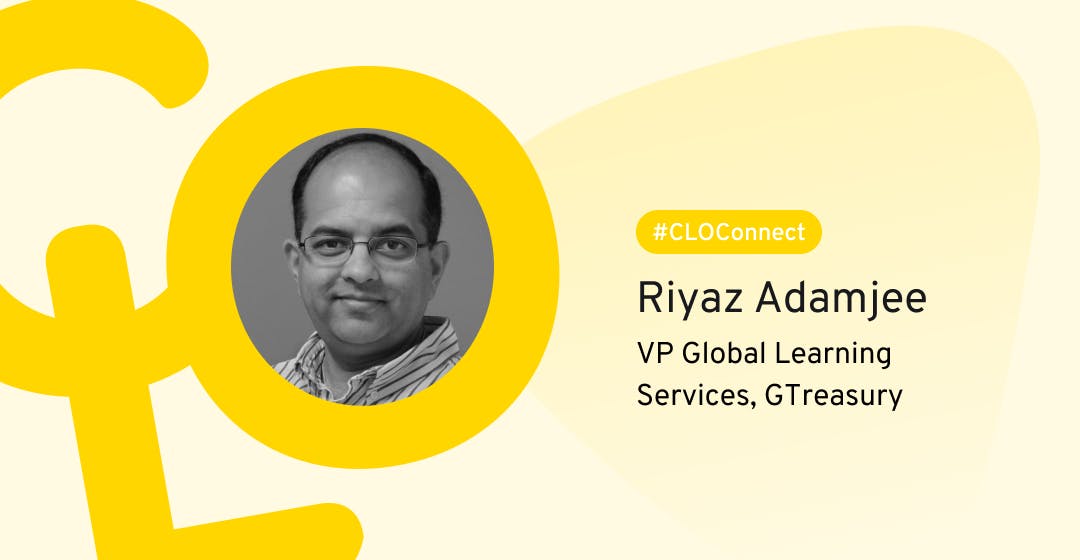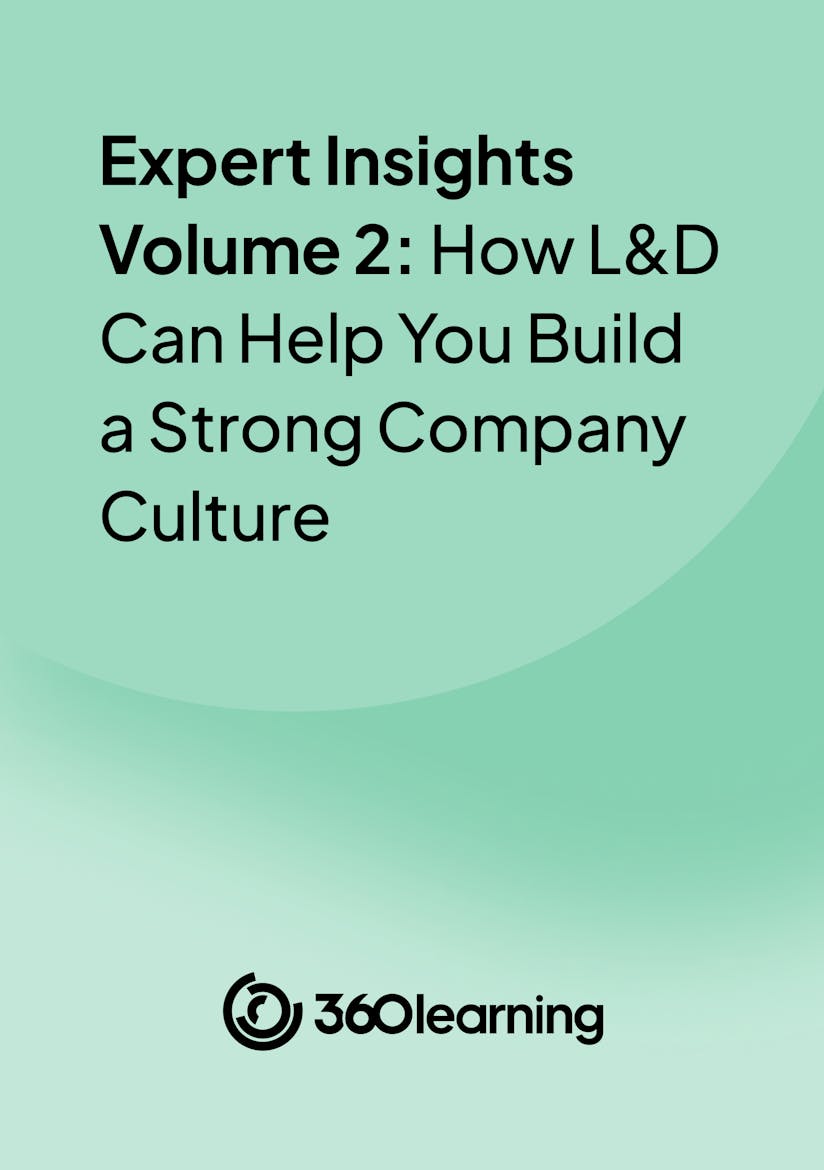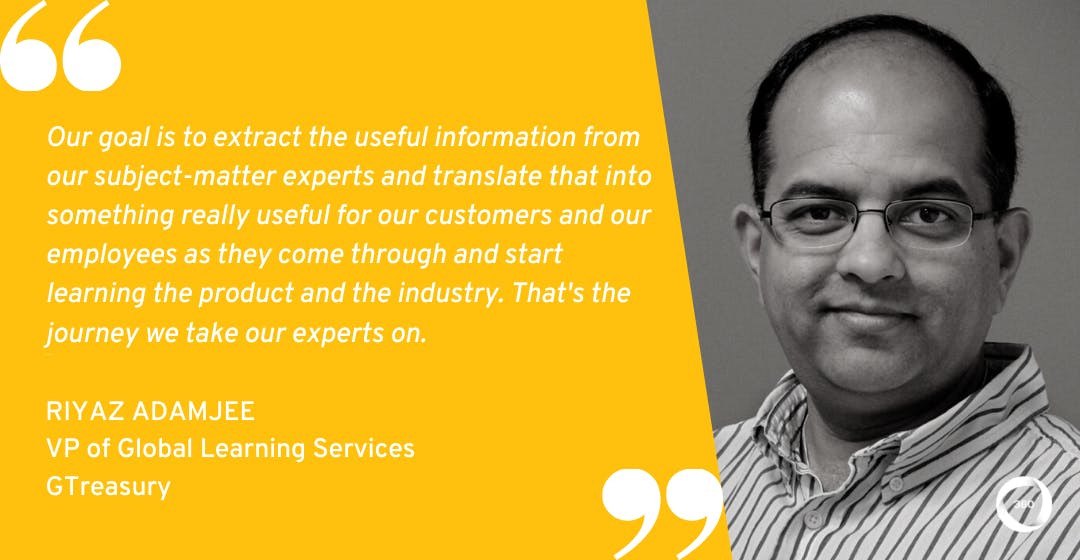
How GTreasury Creates Impactful Learning Experiences Using Subject-Matter Expertise
Today, more and more L&D leaders are recognizing the true engine of learning: subject-matter expertise. But it’s one thing to realize the value of this expertise, and another to turn it into the learning experiences your teams need.
Is there a way to take peer-driven content developed by your subject-matter experts and bring the right level of centralization and consistency? And how can you collaborate with your experts to take the learning experience to the next level?
These critical questions are why it was a pleasure to speak to Riyaz Adamjee, Vice President of Global Learning Services at GTreasury. Recently, Riyaz told me about his method to convert subject-matter expertise into impactful learning experiences that drive his organization in the right direction.
How did Riyaz accomplish it? Read on to learn how!
Loving what you’re reading? Come and join the L&D Collective for more great learning insights, resources, and events!
Taking the first steps towards formalized learning and development
Riyaz kicked off the conversation by describing the biggest challenges facing GTreasury at the moment.
“GTreasury provides a software as a service solution for the treasury industry,” he says. “Every organization has the office of the CFO and, as part of that office, there’s a team that does treasury work. At GTreasury, we provide a solution to manage all of the risk associated with financials.”
As Riyaz describes, GTreasury’s foremost challenge is putting in place a new learning and development structure within the organization.
“From a learning perspective,” he says, “we’ve never really had any formal learning and development. A lot of our development has been run by experts within the team who are familiar with the industry, our product, and then very good at putting the two together.
“But it has always been ad hoc. It was never their day job so to speak, it was more a question of: ‘hey, we need help upskilling or onboarding folks’.”
So, where did Riyaz start his journey to move GTreasury towards a more centralized culture of learning and development? Read on to hear about his approach to leveraging subject-matter expertise.
Need a few more CLO Connect expert insights? Find out how L&D leaders at Harry’s, Robert Half, Disneyland Paris and more are turning L&D into a driver of company culture.

What's company culture without L&D?
By providing your contact info, you agree to receive communications from 360Learning. You can opt-out at any time. For details, refer to our Privacy Policy.
A lot of our development has been run by experts within the team who are familiar with the industry, our product, and then very good at putting the two together.
GTreasury’s 3 steps for converting subject-matter expertise into learning content
As Riyaz explains, he joined the company in August 2021 with a single goal in mind: formalizing what learning and development is at GTreasury.
“We started by paying close attention to the voice of our employees and our customers. This helped us understand the knowledge gaps and what we need to do to fill those.”
Riyaz and his team adopted a three-step process to capture subject-matter expertise and turn it into centralized learning and development content.
Their first step? Collaboration.
We started by paying close attention to the voice of our employees and our customers. This helped us understand the knowledge gaps and what we need to do to fill those.
Phase 1: Collaborate with subject-matter experts
First, as Riyaz explains, collaboration is always about understanding where the experts are coming from. For example, do they have a product or a customer focus? Then, he can bring it all together with the learner in mind.
“A lot of our subject-matter experts may have domain knowledge,’ Riyaz says. “They may have product knowledge, but the main challenge is: how do you translate that to be more learner-focused? That’s always the discussion we have with them, and that’s part of the strategic direction.”
“That’s the journey we take our subject-matter experts on. Our goal is to extract the useful information from them and translate that into something really useful for our customers and our employees as they come through and start learning the product and the industry.”

Phase 2: Create courses from subject-matter expertise
Next, Riyaz and the team looked at the learnings provided by their internal experts–about 40 hours’ worth of recorded training.
“We took the PowerPoints,” explains Riyaz, “the recordings, and split them up into logical pieces that we could use to create e-learning courses. The idea was we’d take those courses and as soon as the LMS is up and running, we could populate those, create learning paths, and make it easy.”
“So, automatically, we’ve started to make learning a little bit more sustainable. Then, you can expand to more people watching the videos and learning from them.”
Related: The Answers Are Right Here: Upskill From Within and Get Up to Speed With Your Next Big New Idea
So, automatically, we’ve started to make learning a little bit more sustainable. Then, you can expand to more people watching the videos and learning from them.
Phase 3: Enhance content to be engaging and interactive
Finally, the L&D team polished the content developed using their organizational subject-matter expertise.
“It’s about taking a hard look at what that content looks like,” Riyaz says, “and asking ourselves how we can create engaging, interactive e-learning courses–especially around onboarding our employees and customers as they get introduced to GTreasury.”
“One of the biggest challenges you always have to deal with as L&D professionals is that we don't want to document everything. We don't want to create a course with every single nuance that’s out there.”
Riyaz explains that he likes to focus on what he calls his Happy Path. “What is the most useful information that will cover the majority of your customers? If that’s documented in e-learning or videos, that’s the most important thing, because you get the biggest bang for your buck. Focus on that 80% and you’ll go a long way.”
GTreasury’s method for leveraging subject-matter expertise spotlights the advantages of Collaborative Learning. By collaborating with subject-matter experts who know the industry and product, Riyaz and his team can develop engaging and targeted content that benefits both employees and customers as learning and development grows within the organization.
Related: How VNA Health Group Welcomes New Nurses with a Targeted Peer-to-Peer Residency Program
Measuring the impact of converted subject-matter expertise content
That’s the method Riyaz and the team implemented to create engaging centralized learning content from subject-matter expertise. But how does the L&D team know they are creating impactful learning experiences?
“We’ve started to look at the KPIs,” Riyaz explains, “and we’ve started to measure some of those. Until we have our learning platform up and running, we won't be able to measure usage and those kinds of metrics.”
“I think it’s really important to focus on your organization’s KPIs. What’s important to the C-suite? Is it annual recurring revenue? Is it productivity? Is it engagement? And then you can tie your learning KPIs to those metrics, because you want to show that you’re making a difference.”
Riyaz provided two examples of aspects that the L&D team is focusing on when measuring the success of their learning strategy.
1. Performance
“How quickly can we get somebody new joining the organization to become productive?” says Riyaz. “For example, in sales. When do they make their first sale? We can measure that, because you may have a number prior to implementing L&D in the organization that you can measure after.”
“It’s the same thing on the service side. How quickly can a new person as part of the implementation team complete implementation? How quickly can our support teams troubleshoot these problems?”
2. Engagement
“The second factor is engagement, both on the employee side and the customer side,” says Riyaz. “As you send out your annual surveys, you want to see that needle moving in the right direction.”
“But you also want to see engagement in customer satisfaction on the customer side. You want to show that the customers are satisfied and the change that you have brought from an L&D perspective has made a positive difference.”
Related: 3 Data-Based Ways To Prove Training ROI (+ Free Training ROI Calculator)
I think it’s really important to focus on your organization’s KPIs. What’s important to the C-suite? Is it annual recurring revenue? Is it productivity? Is it engagement?
Thanks to Riyaz for taking the time to share his valuable knowledge and experience with us!
If you’re looking for more expert insights on how to leverage internal expertise amongst learners, don’t miss our interviews with Shaun Krietemeyer of Opendoor about using peer learning to meet learners where they are, and with Maggie Romanovich of Constellation Brands about flipping classroom training and freeing peer experts.
Want more peer insights on transforming workplace learning? Sign up to become a member of the L&D Collective, and check out our other #CLOConnect interviews with top L&D leaders on driving growth and scaling culture through Collaborative Learning. Or you can subscribe (below 👇) to our weekly newsletter to receive our latest posts directly in your inbox.

